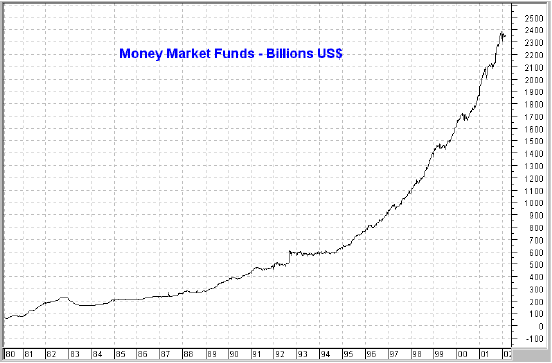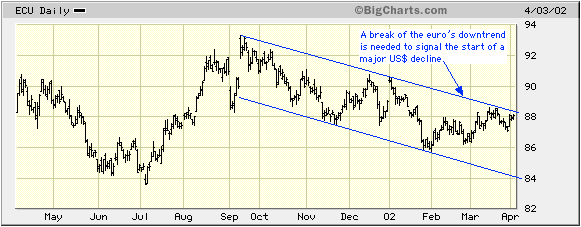
Cash on the
sidelines
The following is an extract from
commentary that was posted at www.speculative-investor.com on 4th April
2002.
Cash on
the sidelines
One of the arguments often put forward
for a substantial stock market rally is that there is a huge amount of
cash on the sidelines. In other words, there is a lot of money sitting
in interest-bearing accounts, earning less than 2% per year, that is eventually
going to flood into the stock market in search of better returns and drive
stock prices much higher. The big assumptions here are that 1) people will,
indeed, decide to choose a riskier asset over cash, and 2) that the assets
they choose will be stocks or mutual funds.
The Japanese experience over the past
12 years has proven that the first assumption is, under certain conditions,
invalid. The majority of people sometimes do prefer to keep their
funds in an interest-bearing account, even if the interest rate is almost
zero. But what are those conditions under which cash will be the investment
of choice? Quite simply, when the prices of the main alternatives to cash
are in long-term downtrends. This is because a rising price stimulates
investment demand, not the other way around. If the price of any alternative
to cash appears to be on a downward path then that alternative will not
be an attractive option for the holder of cash. As prices fall around him
the holder of cash sees the relative value of his cash increase, so the
fact that he might be getting paid an interest rate close to zero is irrelevant.
The second assumption - that someone
who is eager to invest his or her cash in a riskier asset class will choose
the stock market - is invalid for the same reason that the first assumption
is invalid. The stock market will only be the preferred alternative to
cash if stock prices are trending higher. If the major stock indices are
perceived to be trendless or in long-term downtrends, the 'cash on the
sidelines' will not find its way into the stock market. The vast majority
of people only consider buying an investment after they are convinced that
the price is trending higher and they only become convinced after prices
have already moved substantially higher.
The below chart, provided to us by
Nick Laird at http://www.cairns.net.au/~sharefin/Markets/Master.htm,
illustrates the growth in money-market fund assets since 1980. Notice how
money-fund assets have surged over the past 2 years, a period during which
the major stock indices have fared quite poorly. To the extent that the
growth in money-fund assets reflects a growth in the total supply of money,
some assets will have already benefited from this 'cash on the sidelines'.
For example, the real estate market and some sectors of the stock market
have done well over the past 2 years. However, the rapid growth in money-fund
assets has not done anything for technology and internet stocks and there
is certainly no reason to expect that additional rapid growth will be a
boon to the former high-fliers.

In summary, it is completely wrong
to assume that a mountain of 'cash on the sidelines', such as the 2.4 trillion
dollars currently sitting in money-market funds, is necessarily going to
find its way into the stock market. The cash will be drawn to whatever
assets are rising in price and if no assets are rising in price the
cash will remain in an interest-bearing account, even if the interest rate
is zero.
The Dollar
Our analysis of the currency market
over the past 2 months can be neatly summed-up as follows:
a) The Dollar Index has either already
peaked or is close to a peak in terms of both price and time
b) The traders' commitments data and
the euro's failure to break its 6-month downtrend suggest that a final
surge in the US$ (not necessarily to a new high) is a distinct possibility
prior to the start of a substantial decline
Below is a daily chart of the euro
showing that this currency is still mired within its downtrend, but that
any significant strength from here would create an upside breakout. A daily
close above 0.89 would do it.

In the short-term, is a rising US$
a positive or a negative for the US stock market? A rising US$ is often
considered to be a net positive for the stock market because it tends to
attract foreign capital into the US, although this assumes that a significant
proportion of any foreign investment will flow towards equities. As discussed
earlier in today's commentary, investment demand shifts towards those investments
that are rising in price so such an assumption may not be valid. An argument
can also be made that a rising US$ is a negative influence because the
foreign-sourced profits of US multi-national corporations are reduced by
a stronger Dollar.
For whatever reason, the Dollar has
generally moved in the opposite direction to the major US stock indices
since the beginning of this year. Referring to the above chart, note that
the euro hit the top of its channel in early-January and then again in
mid-March. These short-term peaks for the euro (short-term lows for the
Dollar) corresponded with short-term peaks in the US stock market.
Further to the above, a continuation
of the stock market's short-term downtrend would be more consistent with
Dollar strength than Dollar weakness.
Regular financial market forecasts
and
analyses are provided at our web site:
http://www.speculative-investor.com/new/index.html
One-month free trial available.

|

